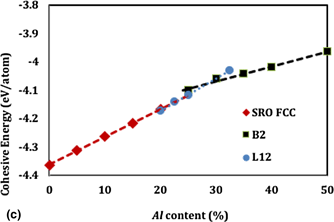Crossref Citations
This article has been cited by the following publications. This list is generated based on data provided by
Crossref.
Jiang, Jun
Chen, Pengwan
Qiu, Jiali
Sun, Weifu
Saikov, Ivan
Shcherbakov, Vladimir
and
Alymov, Mikhail
2021.
Microstructural evolution and mechanical properties of AlxCoCrFeNi high-entropy alloys under uniaxial tension: A molecular dynamics simulations study.
Materials Today Communications,
Vol. 28,
Issue. ,
p.
102525.
Hasan, Md Abdullah Al
Wang, Jiaqi
Shin, Seungha
Gilbert, Dustin A.
Liaw, Peter K.
Tang, Nan
Liyanage, W.L. Namila C.
Santodonato, Louis
DeBeer-Schmitt, Lisa
and
Butch, Nicholas P.
2021.
Effects of aluminum content on thermoelectric performance of Al CoCrFeNi high-entropy alloys.
Journal of Alloys and Compounds,
Vol. 883,
Issue. ,
p.
160811.
Jarlöv, Asker
Ji, Weiming
Zhu, Zhiguang
Tian, Yuanyuan
Babicheva, Rita
An, Ran
Seet, Hang Li
Nai, Mui Ling Sharon
and
Zhou, Kun
2021.
Molecular Dynamics Study on the Strengthening Mechanisms of Cr-Fe-Co-Ni High-Entropy Alloys Based on the Generalized Stacking Fault Energy.
SSRN Electronic Journal ,
Doan, Dinh-Quan
Fang, Te-Hua
and
Chen, Tao-Hsing
2021.
Microstructure and composition dependence of mechanical characteristics of nanoimprinted AlCoCrFeNi high-entropy alloys.
Scientific Reports,
Vol. 11,
Issue. 1,
Chen, Jianjun
Ding, Yutian
Zhang, Xia
Gao, Yubi
and
Ma, Yuanjun
2022.
Intrinsic stacking fault energy and mechanism for deformation twin formation of solid solution matrix in Ni-based superalloys.
Vacuum,
Vol. 203,
Issue. ,
p.
111322.
Zhang, Luming
Xin, Hao
Zhao, Dan
Li, Zhiqiang
and
Ma, Shengguo
2022.
Effect of Twin Boundary Density on Mechanical Behavior of Al0.1CoCrFeNi High-Entropy Alloy by Molecular Dynamics Simulation.
Frontiers in Materials,
Vol. 9,
Issue. ,
Lu, Yu-Sheng
Chang, Man-Ping
and
Fang, Te-Hua
2022.
Phase transformation and microstructure evolution of nanoimprinted NiCoCr medium entropy alloys.
Journal of Alloys and Compounds,
Vol. 892,
Issue. ,
p.
162138.
Vu, Thi-Nhai
Pham, Van-Trung
and
Fang, Te-Hua
2022.
Influences of grain size, temperature, and strain rate on mechanical properties of Al0.3CoCrFeNi high–entropy alloys.
Materials Science and Engineering: A,
Vol. 858,
Issue. ,
p.
144158.
Xu, Q.
Şopu, D.
Yuan, X.
Kiener, D.
and
Eckert, J.
2022.
Interface-related deformation phenomena in metallic glass/high entropy nanolaminates.
Acta Materialia,
Vol. 237,
Issue. ,
p.
118191.
Sun, Zerui
Shi, Changgen
Gao, Li
Lin, Sunlang
and
Li, Wenxuan
2022.
Thermal physical properties of high entropy alloy Al0.3CoCrFeNi at elevated temperatures.
Journal of Alloys and Compounds,
Vol. 901,
Issue. ,
p.
163554.
Jiang, Jun
Sun, Weifu
and
Luo, Ning
2022.
Atomic insights into effects of temperature and grain diameter on the micro-deformation mechanism, mechanical properties and sluggish diffusion of nanocrystalline high-entropy alloys.
Materials Today Communications,
Vol. 33,
Issue. ,
p.
104224.
Babicheva, Rita
Jarlöv, Asker
Zheng, Han
Dmitriev, Sergey
Korznikova, Elena
Ling Sharon Nai, Mui
Ramamurty, Upadrasta
and
Zhou, Kun
2022.
Effect of short-range ordering and grain boundary segregation on shear deformation of CoCrFeNi high-entropy alloys with Al addition.
Computational Materials Science,
Vol. 215,
Issue. ,
p.
111762.
Zhao, Ziyu
and
Liu, Jinxing
2022.
On Cyclic Plasticity of Nanostructured Dual-Phase Cocrfenial High-Entropy Alloy: An Atomistic Study.
SSRN Electronic Journal ,
Fang, Qihong
Lu, Weizheng
Chen, Yang
Feng, Hui
Liaw, Peter K
and
Li, Jia
2022.
Hierarchical multiscale crystal plasticity framework for plasticity and strain hardening of multi-principal element alloys.
Journal of the Mechanics and Physics of Solids,
Vol. 169,
Issue. ,
p.
105067.
Zhao, Youle
Song, Qinghua
Ji, Hansong
Cai, Wentong
Liu, Zhanqiang
and
Cai, Yukui
2022.
Multi-scale modeling method for polycrystalline materials considering grain boundary misorientation angle.
Materials & Design,
Vol. 221,
Issue. ,
p.
110998.
Zhao, Ziyu
and
Liu, Jinxing
2022.
On cyclic plasticity of nanostructured dual-phase CoCrFeNiAl high-entropy alloy: An atomistic study.
Journal of Applied Physics,
Vol. 132,
Issue. 16,
Zhang, Nan
Gan, Kefu
and
Li, Zhiming
2022.
Atomistic insights on the deformation mechanisms of Cox(CrNi)100-x multicomponent alloys: The effect of Co content.
Computational Materials Science,
Vol. 211,
Issue. ,
p.
111559.
Kong, Jiyun
Tian, Yuanyuan
Zeng, Xin
Liu, Bin
Fang, Qihong
and
Li, Jia
2022.
Friction and wear behavior of a precipitation-hardened equiatomic FeCrNi medium entropy alloy unraveled by molecular dynamics simulation.
Journal of Materials Research,
Vol. 37,
Issue. 18,
p.
3009.
Singh, Shailesh Kumar
Kumar, Govind
Babu, Pokula Narendra
Pal, Snehanshu
Vashistha, Saurabh
Azam, M. S.
and
Dixit, Saurabh
2022.
Small-scale deformation behaviour of the AlCoCrFeNi2.1 eutectic high entropy alloy.
Philosophical Magazine,
Vol. 102,
Issue. 17,
p.
1708.
Abere, Michael J.
Ziade, Elbara
Lu, Ping
Saltonstall, Christopher B.
Gu, Xiaojun
Wright, Wendelin J.
Argibay, Nicolas
and
Kustas, Andrew B.
2022.
A predictive analytical model of thermal conductivity for aluminum/transition metal high-entropy alloys.
Scripta Materialia,
Vol. 208,
Issue. ,
p.
114330.






